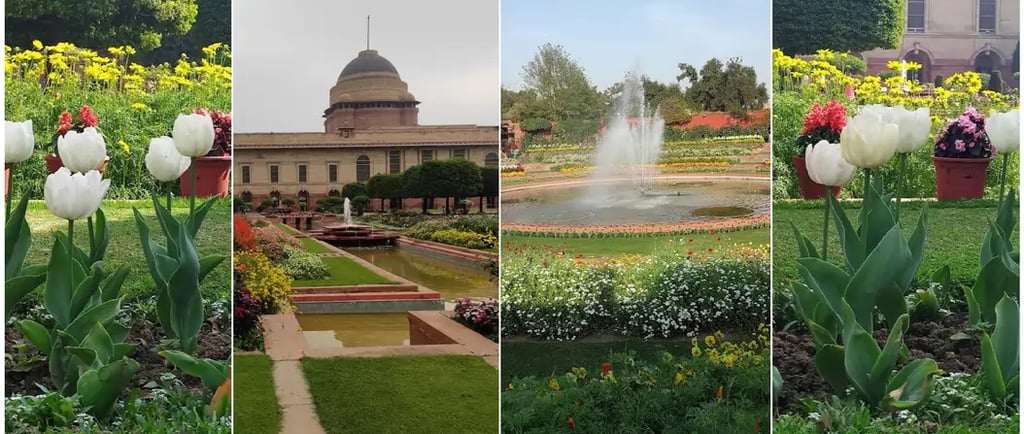Amrit Udyan Reopens August 2025: The Ultimate Guide to Delhi’s Monsoon Paradise
Your complete, expert guide to visiting Amrit Udyan in August-September 2025. Discover dates, timings, free ticket booking, new attractions like the Babbling Brook, what to see, and how to beat the crowd.


A Different Kind of Bloom – Delhi’s Monsoon Spectacle
As the rainy season covers Delhi in fresh greenery, the beautiful gardens of Rashtrapati Bhavan are getting ready for a rare treat. Usually, these gardens open in spring, but this time, you can see them during the monsoon — in a cool, refreshing, and romantic setting.
The President’s Secretariat has announced that Amrit Udyan will be open to the public for its second annual Udyan Utsav-II from August 16 to September 14, 2025. This is your chance to enjoy the gardens filled with colourful summer flowers, raindrops on petals, and the pleasant smell of wet soil.
This year will be extra special with new attractions like the peaceful ‘Babbling Brook’ and a fun ‘Floral Clock’. This guide will give you all the details you need so you can make the most of your visit to this monsoon wonderland.
From Mughal Gardens to Amrit Udyan: The Story Behind the Name
Inside the 380-acre President’s Estate in Delhi lies a beautiful 15-acre garden, often called the “heart” of Rashtrapati Bhavan. For many years, people knew it as the Mughal Gardens. But in 2023, during the celebrations of 75 years of India’s Independence (Azadi ka Amrit Mahotsav), President Droupadi Murmu gave it a new name — Amrit Udyan, meaning “Garden of Nectar.”
The garden’s style is a mix of different cultures. It was designed by British architect Sir Edwin Lutyens, who combined the neat, symmetrical style of the Mughal Char Bagh (four-part garden with water channels) with the open, flowing style of English gardens. The result is a space that is both grand and romantic.
The old name, “Mughal Gardens,” reflected the design inspiration but not the actual creator. The new name, “Amrit Udyan,” is symbolic — part of India’s effort to give its landmarks names that reflect the nation’s own identity rather than its colonial past. This change tells the story of how India is embracing its heritage while moving forward.
Two Seasons, Two Experiences: Udyan Utsav-I and Udyan Utsav-II
Amrit Udyan now opens to the public twice a year, giving visitors two very different garden experiences.
Udyan Utsav-I is the traditional spring opening, held from February to March. This is the most famous time to visit, when the gardens burst into colour with more than 140 types of roses, thousands of tulips, bright daffodils, and exotic lilies. The weather is pleasant, making it a favourite outing for Delhi’s spring season.
Udyan Utsav-II is the newer monsoon edition, introduced in 2023 and held from August to September. Instead of spring flowers, you’ll see blooms that love the rain, like periwinkle, celosia, tuberose, portulaca, and Indian shot. The colours are softer, but the greenery is richer, with raindrops adding a magical touch.
Udyan Utsav-II: What to See in August–September 2025
Monsoon Magic: Flowers in Full Bloom
During the monsoon opening, Amrit Udyan turns into a rain-washed paradise filled with flowers that love this season. You’ll see over 42 varieties of summer blooms — the soft shades of periwinkle, the fiery plumes of celosia, the tall and bright Indian shot, the fragrant tuberose, and the colourful portulaca. Adding to the charm are ornamental plants like the striped Song of India, fan-shaped Raphis palms, and beautifully patterned Aglonema crotons that bring extra texture and depth to the gardens.
New Highlights for 2025
The Babbling Brook – Replacing the old musical fountain, this new water feature feels like a natural stream with gentle cascades, sculpted spouts, stepping stones, and a calm reflecting pool. The sound of flowing water creates a peaceful, relaxing atmosphere.
The Floral Clock – Near the historic Pilkhan tree, this working clock is decorated entirely with flowers and colourful pebbles — a blend of timekeeping and garden art.
Banyan Grove & Plumeria Garden – The Banyan Grove offers reflexology paths, Panchtatva trails, and forest-like sounds for a calming, sensory walk. The Plumeria Garden surrounds you with fragrant flowers, grassy mounds, and soothing greenery.
Special displays also make the gardens more accessible, including touch-and-scent plant arrangements for visually challenged visitors, turning the Udyan into a place you can not only see but also feel, smell, and hear.
Your Garden Journey: The Visitor Trail
Bal Vatika – A children’s area with a treehouse inside a 225-year-old Sheesham tree that “tells” its story, along with swings, slides, a nature trail, and a bird information zone.
Herbal Garden – Filled with medicinal and aromatic plants, this section teaches you about nature’s healing side.
Bonsai Garden – Showcasing around 360 miniature trees, perfect for a quiet, reflective stroll.
Central Lawn & Long Garden – Classic Mughal-style lawns with terraces, flower beds, and flowing water channels.
Circular Garden – An amphitheatre-like garden with marigolds, viola, and pansies, centered around a fountain.
Along the way, you can scan QR codes with your phone to learn about the plants and design features in each section, making your visit both beautiful and educational.
On-Site Amenities: Water, Restrooms, and First Aid
Visitor comfort is a priority, and several amenities are available along the public route.
Drinking Water: Provision for purified drinking water is made at various points. Visitors are also permitted to carry their own water bottles.
Restrooms: Toilet facilities are conveniently located for public use.
First Aid: In case of any medical need, first-aid stations are available along the route.
Accessibility: The gardens have been made more accessible for persons with disabilities, with the addition of ramps and information provided in Braille.
Navigating the Crowds: Best Time to Visit & Expectations
While entry to Amrit Udyan is free, this very accessibility leads to it being an extremely popular destination. Visitors should anticipate significant crowds, especially on weekends and public holidays, which can lead to long queues and congested pathways. The timed-slot booking system is in place to regulate this flow, but strategic planning can greatly enhance the experience. The relationship between the free-access policy and crowd density is direct; therefore, a pleasant visit depends on mitigating the effects of this popularity.
Best Day to Visit: To avoid the heaviest rush, plan your visit on a weekday (Tuesday to Friday).
Best Time of Day: Book the earliest morning slots (10:00 AM to 12:00 PM). The gardens are generally cooler and less crowded during these hours.
Time Required: Allocate a minimum of 2 to 3 hours to walk through the entire circuit at a comfortable pace without feeling rushed.
A Taste of India: What to Eat at the Food Court
After your tour of the gardens, a vibrant food court located near the exit offers a variety of refreshments and culinary delights. The court typically serves a range of Indian cuisine, and past festivals have featured a diverse array of regional street food presented by the National Association Of Street Vendors India (NASVI). Expect to find specialties like Mumbai's Sev Puri, Bihar's Litti Chokha, and Varanasi's creamy Malaiyyo.
A special highlight within the President's Estate is the MITTI Cafe. This is a remarkable non-profit initiative that creates sustainable livelihood opportunities for persons with disabilities. Visiting the cafe is a chance to enjoy delicious and wholesome food, such as Samosa Chaat and Kadhi Chawal, while supporting a wonderful social cause.
Special Access & Group Bookings
Special Days: The garden has exclusive visiting days for specific groups to honour their contributions. For the 2025 monsoon opening, these are August 29 for athletes and sportspersons (to mark National Sports Day) and September 5 for teachers (to mark Teachers' Day).
Group Bookings:
For individuals and small groups, a single online booking can accommodate a maximum of 30 visitors.
For school groups, the limit is extended to 100 visitors in a single booking.
Schools and colleges can also make arrangements by contacting the authorities.
It is also noteworthy that students of government schools are offered free entry to the Rashtrapati Bhavan Museum during the Udyan Utsav period, providing an excellent learning opportunity.
